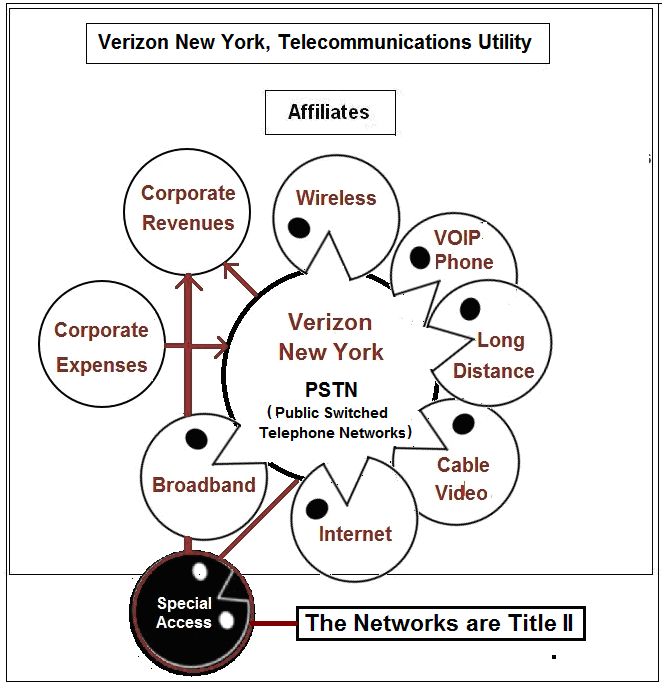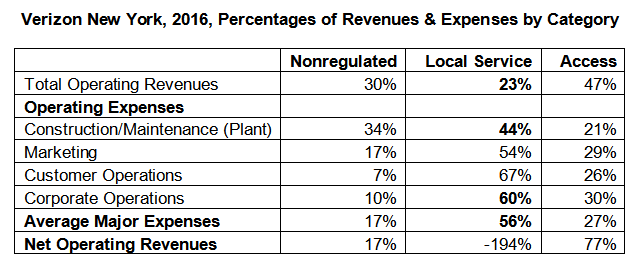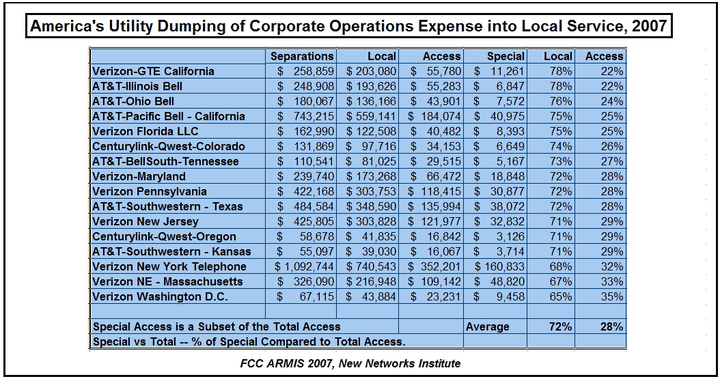The Verizon NY 2016 Annual Report was released at the end of May, 2017 and the IRREGULATORS just put out an analysis: “Follow the Money: Financial Analysis and Implications.” (It part of our ongoing series, Fixing Telecom.)

At the core of this, Verizon NY is still the state-based telecommunications utility serving the majority of New York State. It is a wholly owned subsidiary of the holding company, Verizon Communications. Meanwhile, AT&T California or AT&T Illinois, (controlled by AT&T) or Verizon Massachusetts or Verizon Pennsylvania are also state-based utilities.
Alongside this, there was an ‘evidentiary hearing’ planned for June 26th, 2017 as part of an investigation of the quality of service of Verizon New York’s wireline networks, but also of its business practices. However, as of this writing it appears Verizon has decided it might be time to discuss a settlement. One would suspect the plan is to shut down these proceedings before they get out of hand and to stop further ‘discovery’. Click to read the documents filed. (Some of the issues brought up in this investigation stem from one of our earlier reports published in 2012.)
Based on what we uncovered over the last five years, every state and every city in the US should be demanding answers and calling for investigations of the Verizon, AT&T and CenturyLink incumbent state utilities that control the copper and fiber optic wires (even the wires to the cell sites). Moreover, the FCC needs to be taken to court as its accounting rules are the cause of massive financial cross-subsidies that have been going on for over a decade, and the FCC’s plans are to erase the rules instead of fix them.
Follow the Money: The Primary Findings
Verizon NY’s financials have been manipulated to make local service/the copper wires look unprofitable.
Verizon customers received multiple rate increases based on “massive deployment of fiber optics” and ‘losses’.
The ‘losses’ were not caused by the local service/wireline business, but through various means.
Local Service is paying the majority of all expenses. For example, Local Service is paying 60% of the Corporate Operations expenses.
At the same time, Verizon subsidiaries, like Verizon Wireless, are only paying a fraction of the expenses to use the networks.
Instead of upgrading the cities or even maintaining the existing infrastructure, in NY a large part of the utility capex was diverted to build out the wireless business.
At the same time, “Special Access” services (renamed “Business Data Services”) have a 50+ profit margin, even though they are using the exact same wires as Local Service.
Local phone customers in New York, especially low income families and rural areas, all paid extra—about $1,500 and counting, for these cross-subsidies.
At issue is not just the ‘landlines’ or the wired network but the impacts on all services and companies that use the wires, from competitors offering service to the cost of wireless service.
And, let us stress that while these companies have tried very hard to remove or deny the fact that they are utilities, (like water or electricity), the truth is that these companies control the wires—not only the copper wires but also the fiber optic wires that are used for FiOS or are the wires that go to the cell sites to offer cell phone service or are used for ‘hot spots’. And these are also the wires used for services that are supposed to offer competition to the cable provider or to make sure that there is phone service available so that someone can call E911 in an emergency.
Putting this in Perspective
The Verizon NY 2016 Annual Report is part of and must be seen in light of what is happening throughout the US and at the FCC. First, New York is the only state we found that requires the incumbents to do an annual report, though some states keep the info and require a FOIA request to obtain it. The FCC has never audited these financial books, even though they are making rules that directly impact customers, cities, etc.
FCC’s Corrupted Cost Accounting Rules are to Blame for the Cross-Subsidies.
Worse, the FCC’s accounting rules have caused much of this overcharging as they are set to reflect the expenses based on the year 2000, 17 years ago. In 2001, the FCC ‘froze’ the allocation of costs so that every year, regardless of the revenues, the expenses would be applied as if it was the year 2000. This has made Local Service look unprofitable on paper and has placed the majority of expenses into Local Service. Local Service was 65% of the revenues in 2000 and paid 65% of the expense; in 2016 it is only 23% of the revenues but pays 56% of the expenses. This also had the effect of cross-subsidizing all of the other lines of business in multiple ways as Local Service customers are paying the expenses that should be paid by the other Verizon subsidiaries.
For the excruciating details of this accounting boondoggle see our reports: “The Hartman Memorandum” and “The History & Rules of Setting Phone Rates in America”.
FCC Actions
This current FCC is oblivious to the actual markets, financial data or the public interest, it would seem. In fact, the FCC has multiple proceedings underway or recently decided. The FCC’s plan includes:
“Shut Off the Copper” — The FCC has a group of proceedings to remove all obligations or regulations and is planning on giving the incumbent phone companies, including Verizon New York, the right to ‘shut off the copper’ as a federal law, preempting state laws.
“Business Data Services” (also known as “Special Access”) Deregulation — These services use the same wires that are used for phone service. The FCC has ruled that the incumbents can shut off various classes of these services or not have to rent them at reasonable rates to competitors including the wireless companies. (Sprint and Windstream have already filed an appeal.)
Erasing the FCC’s Accounting Rules — The FCC has multiple current proceedings, some already decided, to erase all obligations, such requiring the use of the Uniform System of Accounting (USOA). The FCC has also extended the ‘freeze’ on how the expenses are allocated until 2018 so it can finish removing all rules instead of fixing them, thus immortalizing the harms.
“IP Transition” — Rarely mentioned anymore, this is actually a plan to shut off the copper and claim that the ‘old’, “Title II” services should be replaced with new services, even though they use the exact same wires. The other part of the plan is to force customers onto wireless.
Net Neutrality, Title II, Privacy — The FCC has decided to kill off Net Neutrality and restrict privacy by letting these few companies control the wires as they see fit, public be damned.
The IRREGULATORS filed in some of these current FCC proceedings.
State Actions: Besides the current investigation in New York:
The Pennsylvania Public Utility Commission just required Verizon to fix parts of the copper infrastructure in some areas where the company has not deployed FiOS, fiber to the home.
The Illinois State legislature voted to remove the obligations of the incumbent telephone companies to offer service or repair the existing service.
With all of these activities one thing is abundantly clear; most of the regulators and politicians have no idea about the actual revenues, expenses and cross-subsidies that are in play. And it is clear that the FCC has never examined the actual impacts of their own distorted accounting rules, but is removing the rules and obligations without basic facts, with the outcome—help the phone companies and harm customers. In fact, the FCC’s ‘shut off the copper’ proceeding never uses the word “utility” in context to the access lines in service, or even mentions how many total lines are in service.
Examining the Financials
Here are two exhibits detailing the revenues and expenses taken directly from the Verizon New York 2016 Annual Report. (Read “Follow the Money” report for details and caveats.)

Verizon New York Revenues and Losses, 2016
(Note: The exhibits are excerpts and not the full accounting.)
$5.2 billion in revenues for wireline telecom services in just New York — The wires are still in use and the utility company is still enormous.
NOTE: These are not all of the revenues of Verizon in New York; it leaves out revenues from Verizon Online, Verizon Business, Verizon Long Distance or Verizon Wireless, among other Verizon affiliates that use the wireline networks.
$1.2 billion of revenue, 23%, are from Local Service.
$2.5 billion of revenue (47%), are from “Access” services (83% are “Business Data Services”).
50% EBITDA for Access services. Using the exact same wires for Local Service, somehow Access services had a whopping 50% profit margin in New York, while Local Service lost money.
$1.1 billion in losses are shown in the 2016 financial report. The report shows that $2.1 billion dollars was claimed as losses for just Local Service.
$1 billion of annual losses for years. Verizon NY claims it keeps losing money (not counting accounting changes) and has been hemorrhaging one billion+ a year since at least 2009.
Not paying most taxes. Verizon New York uses these losses for multiple benefits, including not paying many taxes, which also helps the holding company.
Breakout of the Revenues and Expenses as a Percentage of the Total
But something is seriously amiss. If you examine the percentages of the expenses being charged to Local Service, somehow Local Service is paying the majority of expenses.

Local Service was charged 56% of all expenses, including Corporate Operations, Marketing and Construction and Maintenance (Plant).
Local Service was charged 60% of Corporate Operations, which can include the corporate jets, or the lawyers to defend rate increases or getting rid of Net Neutrality.
Local Service paid 44% of Construction and Maintenance (“Plant”) even though it only generated 23% of revenues.
Even the Number of Access Lines has been Manipulated.
2.2 million “POTS”, plain old telephone service, copper-based Verizon NY lines are in service. These are only a fraction of the total lines, copper or fiber, in place.
“0” Access lines for $4 billion in revenue. The financial report supplies zero lines for either the Access services or the Nonregulated services, which include revenues from part of the FIOS services. How can $4 billion dollars in revenue have no access lines listed?
7-8 million lines are potentially missing from the “landline”/access line accounting. All of the “interstate” services, like special access or FiOS, all lines rented to competitors and all ‘IP-based’ lines are not included in the NY State or FCC or Verizon accounting. I.e., the majority of Verizon NY access lines in use in 2016 have been hidden from view.
Construction Budgets Diverted to Wireless
Much of the construction budgets have been diverted to pay for the wireless networks – which has meant that the cities were not properly upgraded and maintained by the utilities.
5,515 cell sites were built from 2010-2013 at a cost estimated to be $2.8 billion and charged to Verizon New York. According to Verizon’s own press statements, this came out of the wireline construction budgets.
$6.5-$7.5 billion in revenue was generated by Verizon Wireless, we estimate, in just New York State.
Only $69 million was paid to Verizon New York from “Cellco Partners” (Verizon Wireless is a D/B/A) for use of the networks and any construction – which now includes the fiber that was supposed to be used for FiOS, the Fiber to the Home service, but are now wires to the wireless antennas.
Verizon NY Estimated Overcharging and Underbilling
$1.4 billion was overcharged to Local Service based on revenues, in just 2016.
Local Service is profitable if the actual costs were properly assigned.
$1.2 billion of expense was not properly allocated to Access services, based on costs.
$1,500 per line was overcharged to local phone customers through multiple rate increases due to ‘losses’ and “massive deployment of fiber optics” (from 2006-2015).
Prices should have been in steep decline because of major staff cuts and cutbacks in Local Service construction expenses. However, we are told by Verizon, the FCC and State that there is plenty of competition. Isn’t competition supposed to lower prices?
Implications
By claiming Local Service loses money and that the wires are not being used, or that the networks are not profitable enough to even upgrade and maintain, Verizon has manipulated every aspect of public policy.
National Issue; Federal and State Issue
This financial shell game is a state-by-state as well as a national and federal issue as it has been happening in every state and it impacts every city, and it is based on the FCC’s deformed federal accounting rules.
This next exhibit supplies the “Corporate Operations” expense from the FCC’s 2007 “ARMIS” reports which covered the state-based telecom utilities, and it is the last available data. In this exhibit we sorted this group to detail the range of Corporation Operations expense added to the Local Service expenses.
- Throughout America, on average, in 2007, 70+% of Corporate Operations expense had been dumped into Local Service.
- We note that Access paid only 30% of this expense.
- Though it varies by phone company and location, the Verizon California territory (added as part of the GTE merger, which was then sold off to Frontier) dumped a whopping 78% of the Corporate Operations expense into Local Service (intrastate) category, as did AT&T in Illinois.

Conclusion
The Verizon NY 2016 Annual Report reveals a massive cross-subsidy scheme that has been in play for over a decade. It also reveals that there are massive holes in the FCC’s current and proposed plans to erase the accounting rules, shut off the copper, or deregulate special access. Instead, the FCC should be investigating these issues, not attempting to cover them up by erasing the accounting rules. This will only immortalize the cross-subsidies.
The current investigation in New York has been underway for over a year, and it is being spearheaded by the Communications Workers of America, CWA.
We applaud their efforts but for us the examination of the cross-subsidies and financial hanky panky was first documented in our report in 2012, which was filed with the NY State PSC and ignored, as were the multiple updates to that research.
This new Verizon NY 2016 Annual Report shows that while a settlement in New York may curtail some egregious acts, it is not a cure, especially with the FCC’s current plans.
It is time that every state and every city call for and start investigations and use this as a roadmap for change. And it is time to take the FCC to court over their current and proposed plans.
